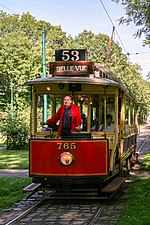Heaton Park

Heaton Park is a public park in Manchester, England, covering an area of over 600 acres (242.8 ha). The park includes the grounds of a Grade I listed, neoclassical 18th century country house, Heaton Hall. The hall, remodelled by James Wyatt in 1772, is now only open to the public on an occasional basis as a museum and events venue.Heaton Park was sold to Manchester City Council in 1902 by the Earl of Wilton. It has one of the United Kingdom's few concrete towers, the Heaton Park BT Tower. The park was renovated as part of a millennium project partnership between the Heritage Lottery Fund and Manchester City Council at a cost of over £10 million. It contains an 18-hole golf course, a boating lake, an animal farm, a pitch and putt course, a golf driving range, woodlands, ornamental gardens, an observatory, an adventure playground, a Papal monument and a volunteer-run tram system and museum, and is listed Grade II by Historic England. It has the only flat green bowling greens in Manchester, built for the 2002 Commonwealth Games.
Excerpt from the Wikipedia article Heaton Park (License: CC BY-SA 3.0, Authors, Images).Heaton Park
Sheepfoot Lane, Manchester Sedgley Park
Geographical coordinates (GPS) Address Nearby Places Show on map
Geographical coordinates (GPS)
| Latitude | Longitude |
|---|---|
| N 53.5347 ° | E -2.2561 ° |
Address
Sheepfoot Lane
M25 0DN Manchester, Sedgley Park
England, United Kingdom
Open on Google Maps








